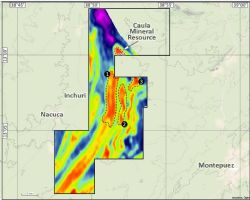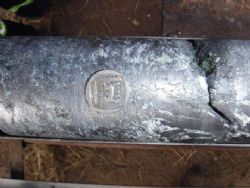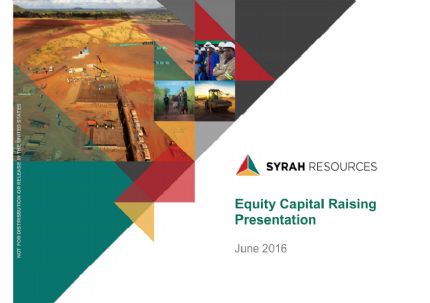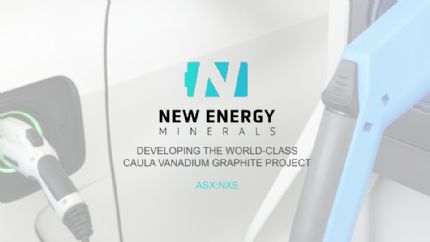4,075m diamond and RC drilling campaign underway to underpin future Resource upgrades and feasibility studies
 Caula Vanadium-Graphite Project - Feasibility Study Drilling Underway
Caula Vanadium-Graphite Project - Feasibility Study Drilling Underway
Sydney, Aug 8, 2018 AEST (ABN Newswire) - Mustang Resources Ltd ("Mustang", the "Company") ( ASX:MUS) (
ASX:MUS) ( GGY:FRA) (
GGY:FRA) ( MTTGF:OTCMKTS) is pleased to announce that the feasibility study drilling program at its flagship Caula Vanadium-Graphite project in Mozambique is well underway. Mustang has planned 4,075m of diamond (DD) and reverse-circulation (RC) drilling to be completed in Q3 of 2018.
MTTGF:OTCMKTS) is pleased to announce that the feasibility study drilling program at its flagship Caula Vanadium-Graphite project in Mozambique is well underway. Mustang has planned 4,075m of diamond (DD) and reverse-circulation (RC) drilling to be completed in Q3 of 2018.
Highlights
- The feasibility study drilling program on the Caula Vanadium-Graphite Project in Northern Mozambique is well advanced with 3,025m of diamond drilling and 1,050m of reverse-circulation drilling planned for completion in Q3
- Caula hosts a JORC (Measured) mica-hosted vanadium resource of 22Mt @ 0.37% V2O5 (0.2% cut-off) for 81,600 tonnes of vanadium pentoxide (180 million pounds) with high grade intersections up to 1.9% V2O5
- Caula also hosts, within the same deposit, a JORC (Measured) graphite deposit of 21.9Mt @ 13.4% TGC (8% cut-off) for 2,933,100 tonnes of contained graphite with high grade intersections of up to 29% TGC
- The project's flowsheet design allows for integrated vanadium and graphite concentrate production, predominately through simple flotation
- Caula vanadium is hosted in roscoelite (a mica mineral) and is expected to be cheaper and simpler to extract than from typical titano-magnetite (VTM) vanadium deposits
- In the USA vanadium was extracted from roscoelite as early as 1910 making the USA the largest vanadium producer in the world by 1941
- Caula Vanadium metallurgy lab work is currently underway at Nagrom Laboratories in Perth
- The scoping study is underway and scheduled for completion in September 2018, expected to be followed by Resource upgrades and feasibility studies in Q4-2018 and Q1-2019
The purpose of the drilling program is to:
1. Expand the existing Caula Vanadium and Graphite JORC Resources
2. Provide additional core samples for feasibility level metallurgical testing programs
3. Conduct geological, geohydrology and geotechnical studies
4. To underpin feasibility studies for the Caula project in Q4-2018 and Q1-2019.
Feasibility Study Drilling Program for the Caula Vanadium-Graphite Project
The drilling program for the Caula Project has been set out by Mustang's independent competent person Mr. Johan Erasmus of Sumsare Consulting, with 3,025m of DD drilling over 18 holes (MODD 33, 34, 35, 41, 36, 37, 38, 42, 43, 44, 45, 23, 24, 25, 21, 28, 29 and 39) and 1,025m of RC drilling over 16 holes (MORC BC 11, 12, 13, 14, 15, 16, 17, 18, 19, 20, 22, 23, 24, 25 and 27) (see Figure 1 in link below). A geological office, including core logging, cutting, sampling and storage facility has also been established and camp and site construction is currently underway.
Mustang Managing Director Dr. Bernard Olivier commented: "This drilling program is a significant step forward for Mustang Resources as we expect to see an expansion of the already valuable Caula Vanadium and Graphite resources. Samples from the drilling will be used to conduct further metallurgical testwork to validate and confirm the Company's previous testwork and reinforce the simplicity of the recovery process. We look forward to updating the market once the results become available."
As shown in Figure 2 below(see link below), the potential exists to expand the Caula Project significantly through the drilling program, which is in progress with independent drilling company, Major Drilling International Inc. ("Major Drilling"). In the immediate vicinity of the Caula discovery, vanadium-graphite mineralisation has now been defined over a 540m strike length (open ended to the south) and this mineralisation is up to 230m wide (estimated true thickness), with the depth being completely open-ended at the limit of the current drilling.
The 4,075m of feasibility study diamond and reverse circulation drilling will test for both up-dip and down-dip extensions to the Caula deposit in this area. In addition to the clear potential to define additional vanadium-graphite mineralisation immediately adjacent to the existing Caula Measured Resource, strong potential exists to define the high-grade vanadium-graphite mineralisation over the significantly larger project area as illustrated in Figure 2 below(see link below).
Vanadium Production from Mica (Roscoelite) Ores
The Caula Vanadium-Graphite deposit (and the deposits along strike to the South of Caula, including the Syrah Balama deposit) provide a unique opportunity to replicate the success achieved by American miners in the early 20th century using a simple and proven process to extract Vanadium.
20th Century Vanadium Mining in the United States(see Note 1 below)
In the United States Colorado Plateau, between 1910 and 1955, there were several operations producing vanadium from micaceous ores, particularly from ores containing roscoelite mica found in near-surface deposits which consisted of sandstone impregnated with vanadium-rich roscoelite, which is the same mineral that occurs in the Caula deposit. Roscoelite, the vanadium mica, is the principal source mineral in the Placerville vanadium deposits and occured as minute flakes coating the grains of sand, and partly or completely filling the pore spaces between grains.
During the period, a number of techniques were used in the recovery of vanadium. As the ore was crushed and ground, mica flakes were often recovered by screening and through means of froth flotation. Mica concentrates were also calcined and then leached as a form of extraction.
A range of processing conditions were used in the treatment of concentrates. In some operations, a salt roast was followed by a water leach, whereas in others, the mica was roasted with other additives such as calcium sulfate and then acid or alkali leached to dissolve the vanadium.
Given the relative simplicity in the processing and treatment of these mica-vanadium deposits, the United States was propelled to become the worlds' largest vanadium producer by 1941. The majority of these deposits, especially the ones with low uranium content, were subsequently mined out and production then shifted to VTM deposits in South Africa and elsewhere.
Syrah Resources Metallurgy Testwork
More recently, in 2014, Syrah Resources ( ASX:SYR) (refer to Syrah Resources "Update on Vanadium Metallurgy" dated 8 April 2014) reported the results of vanadium recovery testwork ore from its Balama project in Northern Mozambique. From the testwork, it was noted that that the application of Wet High Intensity Magnetic Separator ("WHIMS") and mica flotation processes to the graphite flotation tailings, was effective in recovering vanadium and could achieve a combined concentrate grade of > 3% V2O5. Further work showed that commercial grade vanadium pentoxide (98% and 99.9% Purity), which is suitable for battery use, can be produced from this vanadium concentrate.
ASX:SYR) (refer to Syrah Resources "Update on Vanadium Metallurgy" dated 8 April 2014) reported the results of vanadium recovery testwork ore from its Balama project in Northern Mozambique. From the testwork, it was noted that that the application of Wet High Intensity Magnetic Separator ("WHIMS") and mica flotation processes to the graphite flotation tailings, was effective in recovering vanadium and could achieve a combined concentrate grade of > 3% V2O5. Further work showed that commercial grade vanadium pentoxide (98% and 99.9% Purity), which is suitable for battery use, can be produced from this vanadium concentrate.
Mustang Resources Metallurgy Testwork
Mustang Resources metallurgical testwork conducted to date at Independent Metallurgical Operations Pty Ltd ("IMO") and Nagrom, both located in Western Australia, has shown that the vanadium reports to the tailings during the graphite flotation process. Vanadium recovery testwork on the flotation tailings demonstrated that a portion of the vanadium could be recovered and concentrated using WHIMS. The testwork also shows that additional vanadium could be recovered from the WHIMS tailings by a froth flotation procedure, aimed at recovering and concentrating micaceous minerals including roscoelite. This work is at a preliminary stage but has demonstrated strong similarities between the Caula and Balama mineralisation. Ongoing testwork is underway and aimed at optimising vanadium recovery and concentrate grade.
Geology of the Caula Vanadium-Graphite Deposit
The Caula Vanadium-Graphite deposit is located in northern Mozambique in the Cabo Delgado Province (see Figure 5 in link below). The vanadium-graphite mineralisation is hosted in quartzitic schists of the Xixano, with the most common lithologies including Graphitic Schists, Gneisses and thin Pegmatoidal zones. Although Sulphides are occasionally logged, they are usually absent. The surrounding country rock consists of Quarzitic and Micaceous Schists and Gneisses. Vanadium mineralisation is found within the vanadium-mica roscoelite, with up to 17% V2O5 in the mica depending on lattice position substitution and valency states. (see Note 2 below)
The project area is situated in the Mozambique Belt of the East African Orogen, and contains highly metamorphosed meta-sediments and meta-volcanics. The rocks of the East-African Orogen are dated 850 - 620 Ma, in which metamorphic facies vary from amphibolitic to granulitic.
The mineralised zone is contained within a reclined isoclinal fold structure, which dips at roughly 60 degrees to the west (see Figure 6 in link below). Due to the region's tectonic history these meta-sediments have been altered to the extent that no sedimentary structure remains.
Caula Vanadium-Graphite Resource Estimate
The current Caula Mineral Resource estimate is based on 16 diamond drillholes totalling 2,233.21 metres (484.72m in 2016 and 1,748.49m in 2017) and one reverse circulation (RC) drillhole totalling 99 metres (see Figure 4 in link below). Drillholes are spaced approximately 85 metres apart along a 540m strike length. With the exception of drillhole MORC004 (-77deg), all holes were drilled at inclinations of between 55deg and 60deg from the horizontal.
The Measured Vanadium-Graphite Mineral Resource totals 22 million tonnes at an average grade of 0.37% V2O5 and 13.4% TGC for 81,600 tonnes (180 million pounds) of V2O5 and 2,993,100 tonnes of contained Graphite.
The results of the Mineral Resource estimate are summarised in Tables 1 and 2 below(see link below). Drillhole information and reporting in accordance with the JORC Code 2012 Edition are included as Appendices to this announcement(see link below).
Notes:
1 Vanadium the new green metal. Mineral deposits in the Colorado Plateau. Hammond, AD. December, 2013. Mining Engineering Magazine
2 When Vanadium (oxidation state 3+) substitutes for Aluminium in the Muscovite lattice it constitutes up to 17% of the molecule mass. With this Vanadium substitution the mineral is named Roscoelite.
To view tables and figures, please visit:
http://abnnewswire.net/lnk/O9AUW1M0
About New Energy Minerals Ltd
 New Energy Minerals Ltd (ASX:NXE) (FRA:GGY) is an ASX listed junior mining company, that recently announced the divestment of the Company's Caula vanadium - graphite project and the Montepuez Ruby project in Mozambique.
New Energy Minerals Ltd (ASX:NXE) (FRA:GGY) is an ASX listed junior mining company, that recently announced the divestment of the Company's Caula vanadium - graphite project and the Montepuez Ruby project in Mozambique.

![abnnewswire.com]()
Related Companies
Social Media
Share this Article

 ASX:MUS) (
ASX:MUS) ( GGY:FRA) (
GGY:FRA) ( MTTGF:OTCMKTS) is pleased to announce that the feasibility study drilling program at its flagship Caula Vanadium-Graphite project in Mozambique is well underway. Mustang has planned 4,075m of diamond (DD) and reverse-circulation (RC) drilling to be completed in Q3 of 2018.
MTTGF:OTCMKTS) is pleased to announce that the feasibility study drilling program at its flagship Caula Vanadium-Graphite project in Mozambique is well underway. Mustang has planned 4,075m of diamond (DD) and reverse-circulation (RC) drilling to be completed in Q3 of 2018.  ASX:SYR) (refer to Syrah Resources "Update on Vanadium Metallurgy" dated 8 April 2014) reported the results of vanadium recovery testwork ore from its Balama project in Northern Mozambique. From the testwork, it was noted that that the application of Wet High Intensity Magnetic Separator ("WHIMS") and mica flotation processes to the graphite flotation tailings, was effective in recovering vanadium and could achieve a combined concentrate grade of > 3% V2O5. Further work showed that commercial grade vanadium pentoxide (98% and 99.9% Purity), which is suitable for battery use, can be produced from this vanadium concentrate.
ASX:SYR) (refer to Syrah Resources "Update on Vanadium Metallurgy" dated 8 April 2014) reported the results of vanadium recovery testwork ore from its Balama project in Northern Mozambique. From the testwork, it was noted that that the application of Wet High Intensity Magnetic Separator ("WHIMS") and mica flotation processes to the graphite flotation tailings, was effective in recovering vanadium and could achieve a combined concentrate grade of > 3% V2O5. Further work showed that commercial grade vanadium pentoxide (98% and 99.9% Purity), which is suitable for battery use, can be produced from this vanadium concentrate.  New Energy Minerals Ltd (ASX:NXE) (FRA:GGY) is an ASX listed junior mining company, that recently announced the divestment of the Company's Caula vanadium - graphite project and the Montepuez Ruby project in Mozambique.
New Energy Minerals Ltd (ASX:NXE) (FRA:GGY) is an ASX listed junior mining company, that recently announced the divestment of the Company's Caula vanadium - graphite project and the Montepuez Ruby project in Mozambique.























